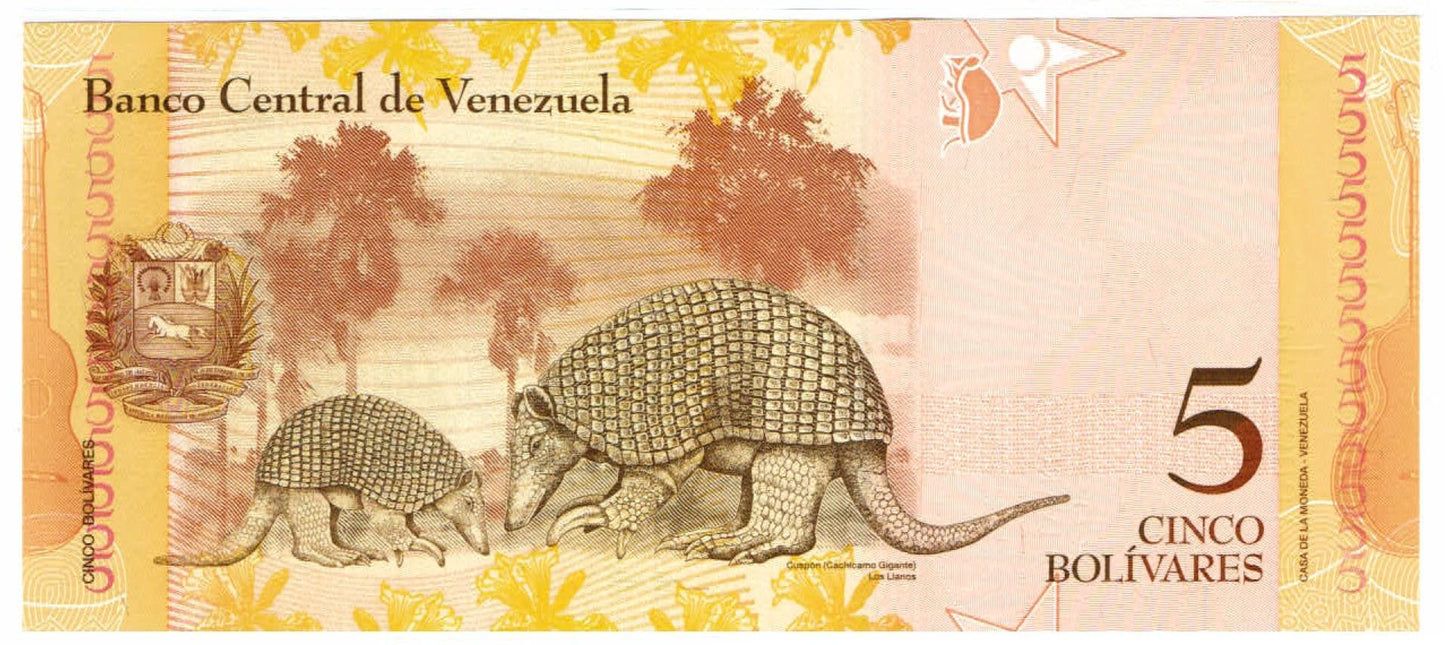elemintalshop
Pedro Camejo 5 Bolivares Venezuela Authentic Banknote for Craft Making (Giant Armadillo)
Pedro Camejo 5 Bolivares Venezuela Authentic Banknote for Craft Making (Giant Armadillo)
Couldn't load pickup availability
Giant Armadillo 5 Bolivares Venezuela Authentic Banknote for Craft Making
Obverse: Image of Negro Primero (Pedro Camejo) at lower centre
Lettering: República Bolivariana de Venezuela
CINCO BOLÍVARES
19 DE AGOSTO 2014
PAGADEROS AL PORTADOR EN LAS OFICINAS DEL BANCO
PRESIDENT PRIMER VICEPRESIDENTE BCV
Translation: Bolivarian Republic of Venezuela
FIVE BOLIVARS
AUGUST 19, 2014
PAYERS TO THE CARRIER IN THE BANK OFFICES
PRESIDENT FIRST VICE PRESIDENT BCV
Reverse: Image of two Giant Armadillos, Venezuelan coat of arms to left
Lettering: Banco Centrale de Venezuela
CINCO BOLIVARES
Cuspón (Cachicamo Gigante)
Los Llanos
CINCO BOLIVARES
CASA DE MONEDA - VENEZUELA
Translation: Central Bank of Venezuela
FIVE BOLIVARES
Cuspon (Giant Cachicamo)
The plains
FIVE BOLIVARES
CURRENCY HOUSE - VENEZUELA
Watermark: Pedro Camejo with numeral 5 below
Features
Issuer Venezuela
Issuing bank Central Bank of Venezuela
Period Bolivarian Republic (1999-date)
Type Standard banknote
Years 2007-2014
Value 5 Bolivars (5 VEF)
Currency Bolívar Fuerte (2008-2018)
Composition Paper
Size 156 × 69 mm
Shape Rectangular
Demonetized Yes
Number N# 203178
References P# 89
Wikipedia:
Pedro Camejo, also known as Negro Primero or 'The First Black' (San Juan de Payara, Captaincy General of Venezuela, 1790-June 24, 1821) was a Venezuelan soldier that fought with the Royal Army and later with the Rebel Army during the Venezuelan War of Independence, reaching the rank of lieutenant. The nickname Negro Primero was inspired by his bravery and skill in handling spears, and because he was always in the first line of attack on the battlefield. It is also attributed to his having been the only black officer in the army of Simon Bolívar.
Biography
It is believed that Pedro Camejo is native to San Juan de Payara. Camejo was one of the 150 lancers who participated in the Battle of Las Queseras del Medio, later receiving the Order of Liberators of Venezuela for his participation. In the Battle of Carabobo, he fought with one of the cavalry regiments of the first division commanded by José Antonio Páez. Eduardo Blanco, in his book Venezuela Heroica, describes the moment when Camejo presented himself before General Páez with an unfailing voice said to him: "My general, I come to tell you goodbye, because I am dead".
************
The giant armadillo (Priodontes maximus), colloquially tatou, ocarro, tatu-canastra or tatú carreta, is the largest living species of armadillo (although their extinct relatives, the glyptodonts, were much larger). It lives in South America, ranging throughout as far south as northern Argentina. This species is considered vulnerable to extinction.
The giant armadillo prefers termites and some ants as prey, and often consumes the entire population of a termite mound. It also has been known to prey upon worms, larvae and larger creatures, such as spiders and snakes, and plants.
Giant armadillos are solitary and nocturnal, spending the day in burrows. They also burrow to escape predators, being unable to completely roll into a protective ball. Compared with those of other armadillos, their burrows are unusually large, with entrances averaging 43 cm (17 in) wide, and typically opening to the west.
Hunted throughout its range, a single giant armadillo supplies a great deal of meat, and is the primary source of protein for some indigenous peoples. In addition, live giant armadillos are frequently captured for trade on the black market, and invariably die during transportation or in captivity. Despite this species’ wide range, it is locally rare. This is further exacerbated by habitat loss resulting from deforestation. Current estimates indicate the giant armadillo may have undergone a worrying population decline of 30 to 50 percent over the past three decades. Without intervention, this trend is likely to continue.
Share



